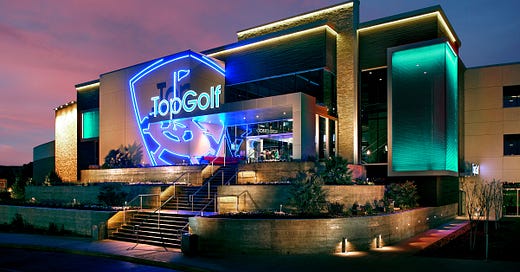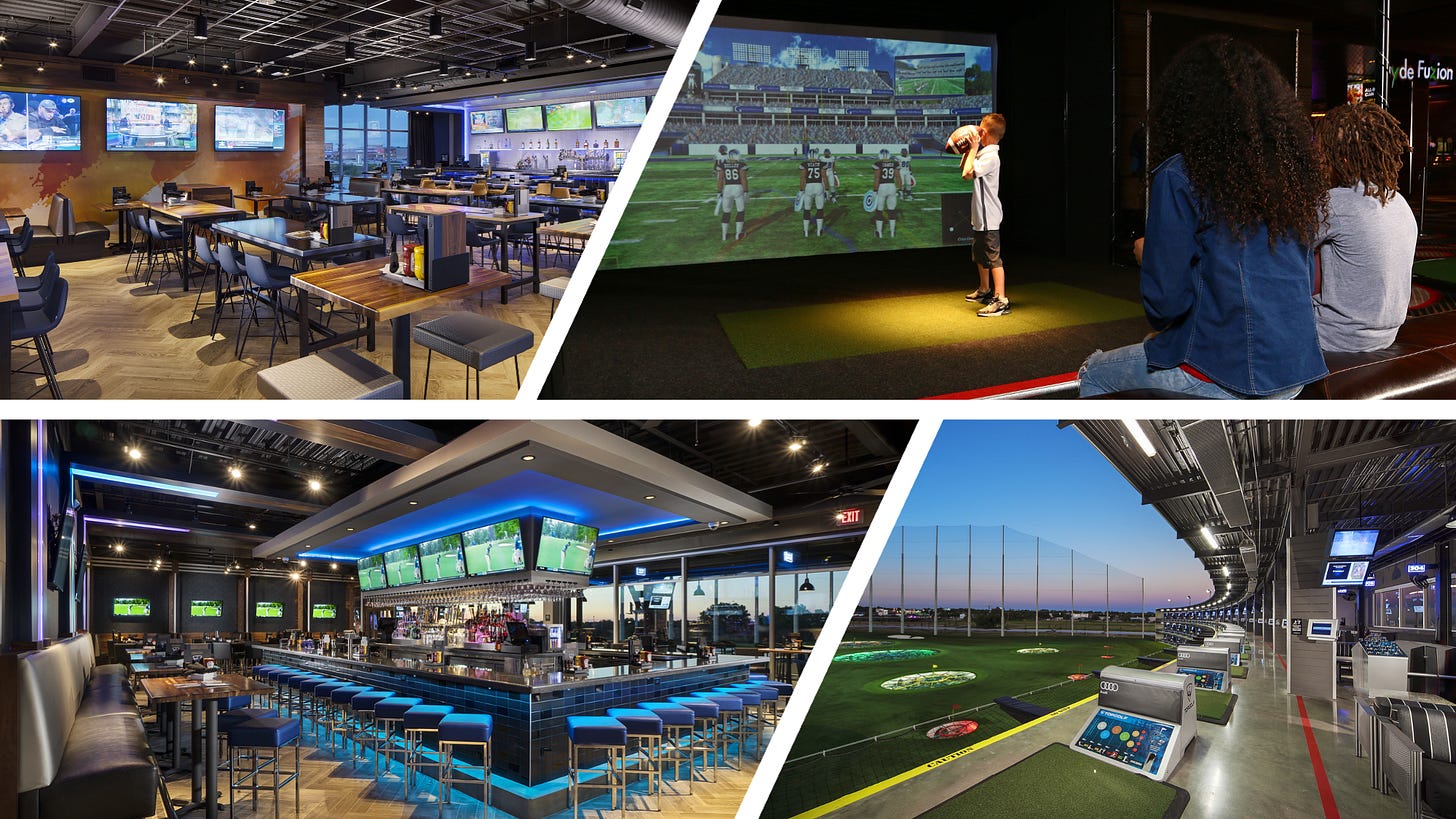A Company that's Growing its Entire Industry
Growing your share of the market isn't easy. Growing the entire market is even harder.
Anyone who has ever swung a golf club can tell you that the sport does not give up its secrets with ease. There is a thin line between crushing a shot straight down the fairway and shanking it deep into the rough. Yet within this thin line, there is enough room for an entire industry selling balls, clubs, clothing, and lessons for beginners, weekend warriors, committed amateurs, and seasoned pros.
And now new technology is opening up this experience to brand new sets of players, extending the game beyond the country clubs and municipal courses most would equate with “golfing.”
This growing golf ecosystem could raise the ceiling for golf lifestyle brands that understand the shift in landscape, can read the terrain, and can find ways to navigate it effectively. For investors used to seeing golf as a niche market with limited growth potential, it could be easy to miss the fairway and ultimately underestimate the magnitude of the opportunities opening up in the coming years.
In a well-established industry, change can be hard to spot
As CEO of Topgolf Callaway Brands (MODG), and golf enthusiast, Chip Brewer told me in a recent World According to Boyar podcast, the golf industry can be deceptively tricky to understand. “In theory, you don’t need to be an avid golfer to run a golf equipment company,” he noted, “But then when you actually look at the tape and look at the track record, it is a perfect record — it never works.”
Whether you believe Mr. Brewer’s assessment or not, recent performance of Topgolf Callaway’s share price suggests that both golfing and non-golfing investors may be missing the potential upside of the sport’s expanding footprint.
When it comes to seeing the forest, the trees can be a real distraction
To be fair, Topgolf Callaway is building on top of a strong foundation and recent tailwinds. In 2021, when the pandemic pushed everybody outdoors, a surge of interest from new and existing golfers brought the number of rounds played to record levels. These new recruits entered a market that had undergone significant consolidation among retailers and manufacturers, a trend that has strongly benefitted the remaining larger players, which includes Topgolf Callaway. Since Brewer’s arrival in 2012, the company’s share of hard goods has grown from 14% to roughly 25%. Its share of the golf ball market (effectively a consumables business, given the rate of loss and wear) has risen from 8% to 21%.
But it was the opportunistic acquisition of Topgolf in 2021 that changed the landscape. A tech-enabled golf business that, at the time of Calloway’s purchase, operated 70 entertainment venues (now 89), Topgolf resembles a cross between a bowling alley, a nightclub, and a driving range. And it produced 2021 revenues on par with the company’s entire golf equipment business. Its potential synergies with Topgolf Callaway, and for the sport more generally, offer a potential for upside that appears to be more difficult for investors to recognize (even as off-course golf participants surpass on-course participation in the U.S.).
Topgolf is changing the game
In a certain sense, it’s easy to understand the attraction to Topgolf. Even (or perhaps “especially”) for those who never intend to set foot on a golf course, the more arcade-like experience it provides can have tremendous appeal. The pandemic played a role in Callaway’s ability to purchase Topgolf, which, despite a period of rapid growth, faced liquidity issues due to mandated venue closures. The business continues to ramp to scale, which is a capital-intensive endeavor.
Brewer estimates that new venues cost $20 million to $55 million to get up and running, a process that can take from three to ten years.
Recent management reports indicate the firm is well on track to reach its targeted unit economics, which include a two-and-a-half-year payback period, 20% return on gross investment, and cash-on-cash returns of 50% to 60%.
Management has noted that Topgolf is expected to add 3 to 4 million new off-course golf participants each year for every 11 new venues, which will help drive growth across the modern golf ecosystem.
However, Topgolf is more than just an opportunistic new business. Roughly 75% of non-golfers who set foot in a Topgolf venue report interest in trying out the sport on a real fairway after the experience. This has potential synergies for the industry, benefiting Topgolf Callaway’s already strong and resilient equipment and apparel segments.
Are investors fully appreciating the magnitude of these changes?
Investors initially recognized the value of the Topgolf transaction, raising the company’s share price to $37. Since then, shares (currently trading around $17) have been pressured as investors appear to be focused on near-term headwinds and uncertainties including softness in their corporate events business and worries about an economic slowdown in the wake of higher interest rates.
Fair points. However:
Topgolf Callaway’s primary customers tend to be higher-income, making the business more resilient in the face of economic slowdowns.
Topgolf also owns a technology called Toptracer, which provides a visual representation of how a ball flies after it’s hit. Toptracer is a high-margin licensing business that generates revenue via multi-year subscriptions, offering an additional source of resilient growth.
All this comes on top of combined expected post-merger synergies of at least $225 million in revenue and $100 million in adjusted EBITDA (from a combination of the revenue synergies plus cost synergies) by 2025.
Stock purchases by both the company and its executives suggest they agree investors aren’t quite getting the full picture. The company itself repurchased $17.8 million worth of shares in the most recent quarter. Adding to this, both Brewer and Callaway CFO Brian Lynch have made multiple purchases of roughly 10,000 shares a piece since the acquisition. “We’re creating a leadership position and a unique competitive advantage in what is a very attractive space right now,” says Brewer.
If that conviction plays out according to plan, the forest could wind up being more than twice the size investors are currently seeing. Our sum-of-the-parts intrinsic valuation of $44 per share would represent roughly 158% of upside from current share prices.
Important Disclosures. The information herein is provided by Boyar’s Intrinsic Value Research LLC (“Boyar Research”) and: (a) is for general, informational purposes only; (b) is not tailored to the specific investment needs of any specific person or entity; and (c) should not be construed as investment advice. Boyar Research does not offer investment advisory services and is not an investment adviser registered with the U.S. Securities and Exchange Commission (“SEC”) or any other regulatory body. Any opinions expressed herein represent current opinions of Boyar Research only, and no representation is made with respect to the accuracy, completeness or timeliness of the information herein. Boyar Research assumes no obligation to update or revise such information. In addition, certain information herein has been provided by and/or is based on third party sources, and, although Boyar Research believes this information to be reliable, Boyar Research has not independently verified such information and is not responsible for third-party errors. You should not assume that any investment discussed herein will be profitable or that any investment decisions in the future will be profitable. Investing in securities involves risk, including the possible loss of principal. Important Information: Past performance does not guarantee future results.
This information is not a recommendation, or an offer to sell, or a solicitation of any offer to buy, an interest in any security, including an interest in any investment vehicle managed or advised by affiliates of Boyar Research. Any information that may be considered advice concerning a federal tax issue is not intended to be used, and cannot be used, for the purposes of (i) avoiding penalties imposed under the United States Internal Revenue Code or (ii) promoting, marketing or recommending to another party any transaction or matter discussed herein. Clients of an affiliate of Boyar Research and employees of Boyar Research own shares in Topgolf Callaway Brands.








